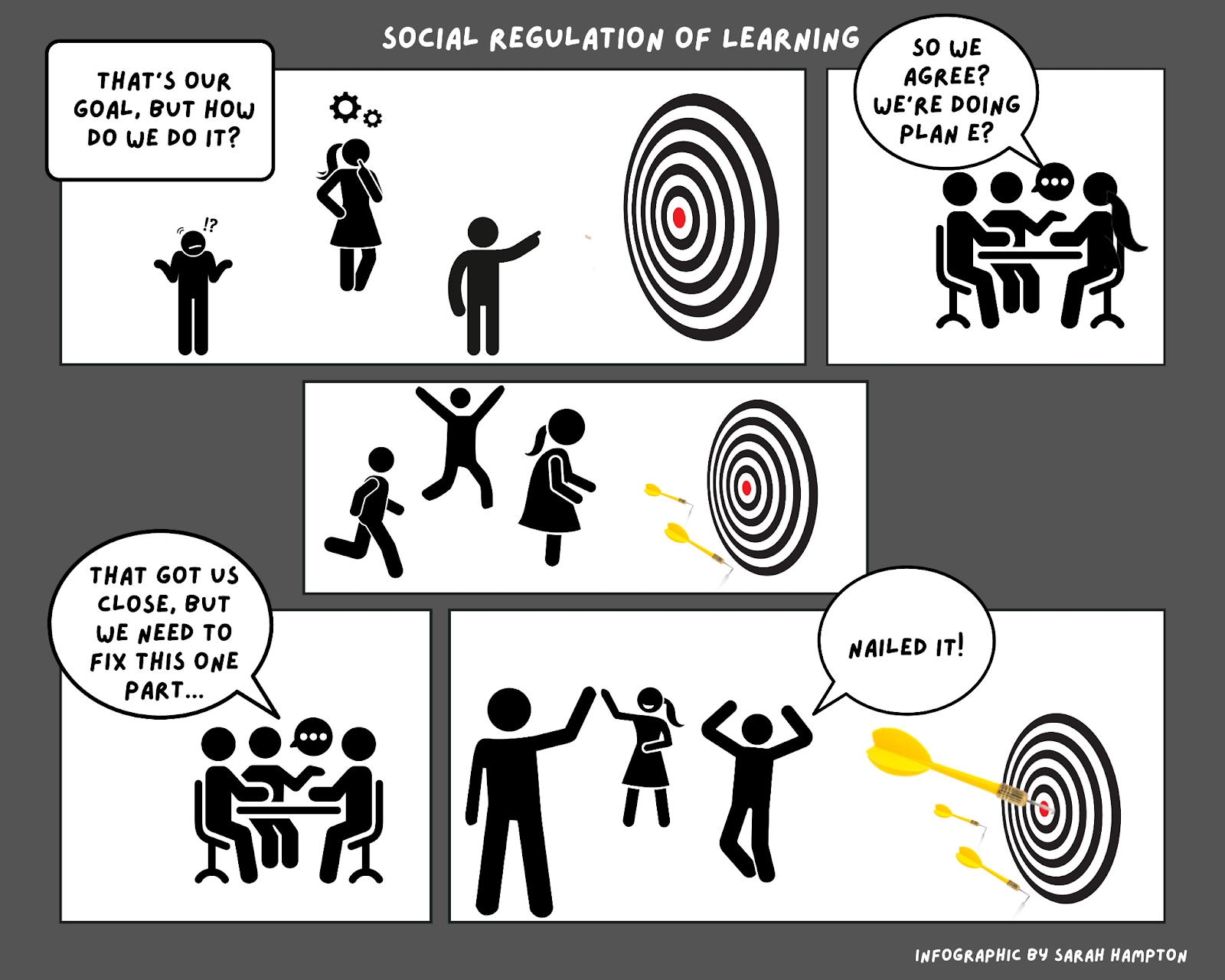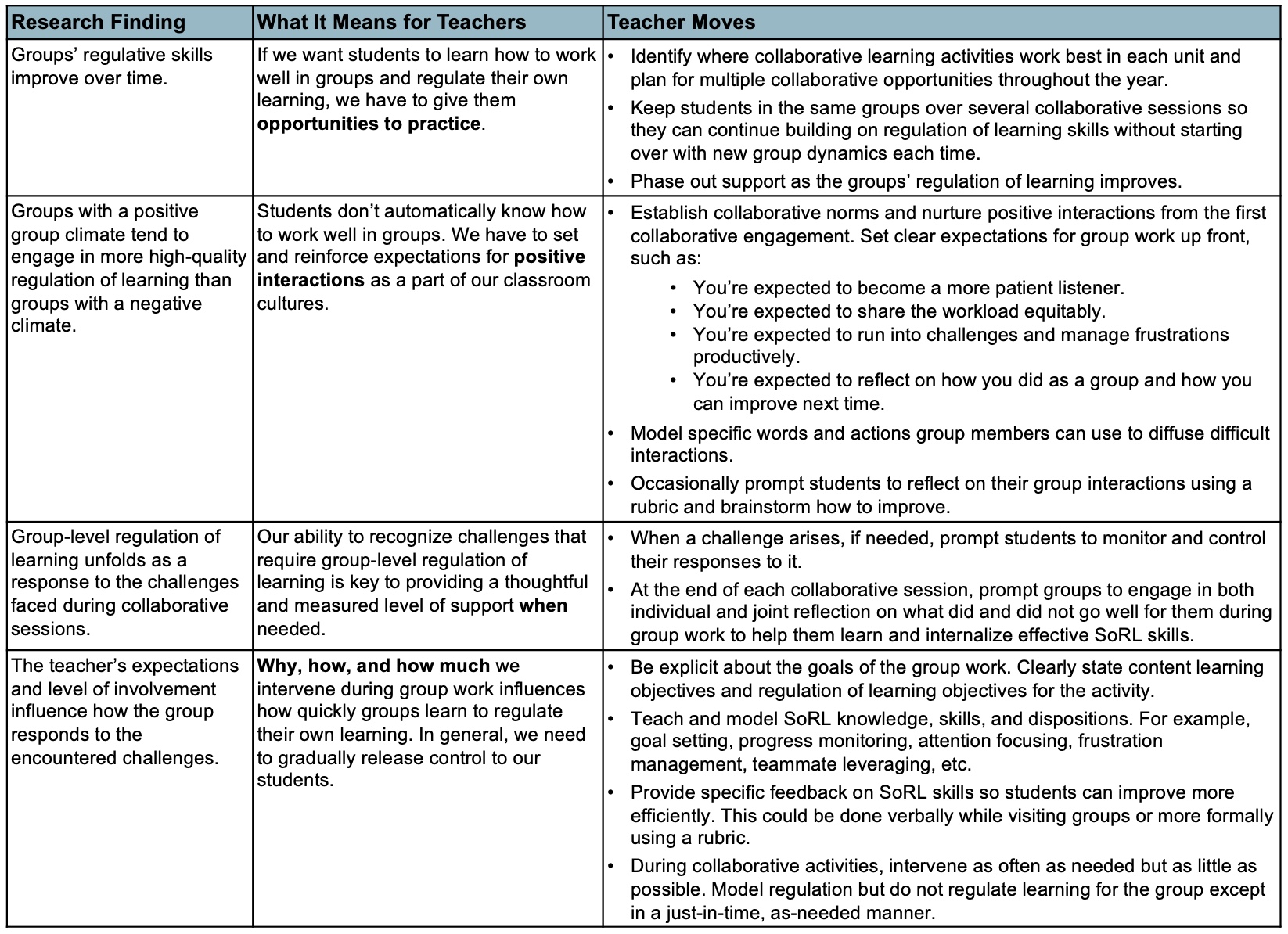by Sarah Hampton and Dr. Dalila Dragnić-Cindrić
In the first post of this series (Hampton & Dragnić-Cindrić, 2023), we focused primarily on individual student’s self-regulated learning (SRL), explained the related key terms and ideas, and discussed why it is important to teach SRL alongside subject content. In this post, we will focus on regulation of learning in small, collaborative groups.
Social regulation of learning (SoRL) occurs when students in collaborative groups purposefully select, use, and, if necessary, adjust their collective actions and behaviors to achieve shared learning goals (Hadwin et al., 2018). Navigating group dynamics and collaborating well are skills all students need. SoRL is an essential prerequisite for successful collaboration (Dragnić-Cindrić & Greene, 2021).
Social regulation of learning (Figure 1) unfolds through the same three loose phases of learning as SRL (i.e., preparation, execution, reflection), and it has the added complexity of coordinating with others. Collaborative groups enact their SoRL by relying on one or more of the following modes of regulation: self-regulated learning (SRL), coregulated learning (CoRL), and socially-shared regulation of learning (SSRL).
These three modes of regulation vary in their focus:
CoRL occurs when one group member temporarily supports one or more others in the group, with the goal of eventually transitioning regulation of learning to the regulated student(s). For example, if a student is repeatedly distracted by looking at another group, a teammate might prompt them a few times to pay attention to their own group. After a few prompts, the “regulated” student might decide to switch seats to fully engage with the group and avoid further disruption.
SSRL is characterized by the equal and balanced participation of all group members in the group’s regulation of learning. During SSRL, group members build on each other’s actions and statements to create synergistic outcomes.
Figure 1. Social regulation of learning infographic

Note: This graphic shows a three-person collaborative group engaging in social regulation of learning. The group first plans how to do the task. Then, they attempt to execute their plan and fail. They reflect on what went wrong and what they needed to change. Finally, they try again and achieve their goal.
When you consider all the ways learners must regulate during group work—self, others, and each other—it’s not surprising that successful collaboration can be challenging. Importantly, students don’t have to regulate their learning all the time. In fact, when students are satisfied with their learning progress, there is no need to regulate. Typically, regulation unfolds as a response to an encountered challenge. For example, some group members might lose their motivation for the task and want to quit. Other group members might need to actively encourage them and point out the progress the group made so far to get them to re-engage.
Most of what we’ve discussed so far has been about what students in the group are doing to regulate their own learning. It is also possible that someone outside the group—the teacher or even a student from another group—might need to help with the group’s regulation of learning. This is called external regulation of learning. For example, a teacher may decide to step in if a group is engaging in excessive off-task behavior or if they are repeatedly trying an ineffective learning strategy.
Such an intervention involves trade-offs between the teacher’s control over the group’s learning and allowing adequate space and time for the students to learn how to socially regulate their own learning (Dragnić-Cindić et al., 2023). Think of it like this— when a child first learns to tie shoelaces, it’s clumsy and time-consuming and requires multiple tries with some help. It would be much faster if a parent tied them instead. However, if the parent repeatedly makes the choice to step in and tie the child’s shoelaces, then the child never has the opportunity to learn. Given enough space and time, the child eventually learns to tie them quickly, and the parent never has to intervene again. Similarly, the teacher’s job is to discern when and how to offer the least assistance possible to help students grow in SRL, CoRL, and SSRL and recognize which mode of regulation is the most appropriate in a given situation.
The quality of a group’s regulation of learning is closely connected to the group climate (Dragnić-Cindrić & Greene, 2021), a persistent pattern of group members’ interactions, emotions, and behaviors that remains stable over time. Successful groups tend to have a positive group climate characterized by positive interactions. For example, group members praise each others’ ideas, offer encouragement when mistakes are made, and joke and laugh together. It is important to establish a positive climate from the first collaborative session, and clear group norms and teacher modeling of desired interactions can help with that. Teachers should step in when off-task or negative behaviors hurt the group climate or even the classroom culture in ways that make growth unlikely.
In other words, rather than managing students directly, teachers should manage the classroom conditions that allow students to manage their own learning. We include research-based teachers’ moves in the table below (Table 1).
Table 1. Research-based recommendations for teachers

In the final blog post of this series, we’ll explore some barriers and potential solutions for teaching regulation of learning in our classrooms. Meanwhile, we would love to hear from you. Are you already incorporating some teacher moves that facilitate regulation of learning in your classroom? If so, which ones? If not, which moves could you implement easily? Let us know by engaging with us on social media @EducatorCIRCLS!
Educator CIRCLS posts are licensed under a Creative Commons Attribution 4.0 International License. If you use content from this site, please cite the post and consider adding: “Used under a Creative Commons Attribution 4.0 International License (http://creativecommons.org/licenses/by/4.0/).”
Suggested citation format: Hampton, S., & Dragnić-Cindrić, D. (2023). Social Regulation of Learning and Insights for Educators. Educator CIRCLS Blog. Retrieved from https://circleducators.org/social-regulation-of-learning-and-insights-for-educators
Acknowledgements
This material is based upon work supported by the National Science Foundation grant number 2101341 and grant number 2021159. Any opinions, findings, and conclusions or recommendations expressed in this material are those of the authors and do not necessarily reflect the views of the National Science Foundation.
Resources
Dragnić-Cindrić, D., & Greene, J. A. (2021). Social regulation of learning as a base for successful collaboration. (Rapid Community Report Series). Digital Promise, International Society of the Learning Sciences, and the Center for Integrative Research in Computing and Learning Sciences. https://repository.isls.org//handle/1/6854
Dragnić-Cindrić, D., Lobczowski, N. G., Greene, J. A., & Murphy, P. K. (2023). Exploring the teacher’s role in discourse and social regulation of learning: Insights from collaborative sessions in high-school physics classrooms. Cognition and Instruction, 1-32. https://doi.org/10.1080/07370008.2023.2266847
Hadwin, A. F., Järvelä, S., & Miller, M. (2018). Self-regulation, co-regulation, and shared regulation in collaborative learning environments. In D. H. Schunk & J. A. Greene (Eds.), Handbook of self-regulation of learning and performance (pp. 83–105). Routledge.
Hampton S., & Dragnić-Cindrić, D. (2023). Regulation of learning: What is it, and why is it important? Center for Integrative Research in Computing and Learning Sciences. https://circleducators.org/regulation-of-learning-what-is-it-and-why-is-it-important
How to cite this work
CIRCL Educator posts are licensed under a Creative Commons Attribution 4.0 International License. If you use content from this site, please cite the post and consider adding: "Used under a Creative Commons Attribution 4.0 International License (http://creativecommons.org/licenses/by/4.0/)."
Suggested citation format: [Authors] ([Year]). [Title]. CIRCLEducators Blog. Retrieved from [URL]
